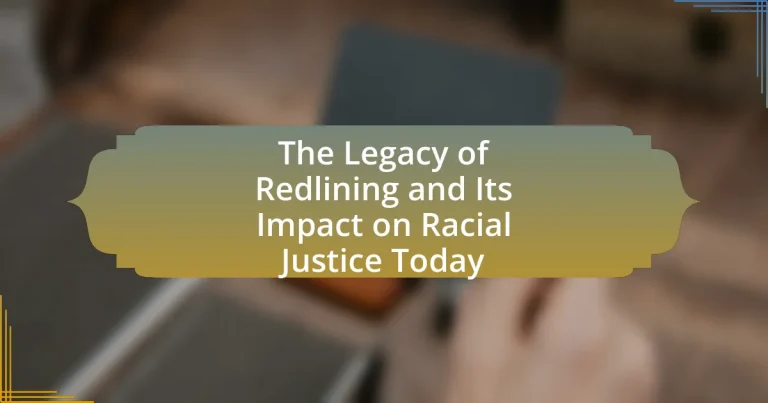The main entity of the article is the legacy of redlining and its ongoing impact on racial justice. The article examines how redlining, a discriminatory housing policy originating in the 1930s, has led to systemic racial segregation and economic disparities in urban areas. It details the historical context of redlining, its effects on urban development, housing markets, and the social and economic consequences for marginalized communities. Additionally, the article discusses current manifestations of redlining’s legacy, including disparities in homeownership, education, and employment, while emphasizing the importance of understanding these issues for racial justice movements and potential policy reforms aimed at addressing these inequities.

What is the Legacy of Redlining?
The legacy of redlining is the systemic racial segregation and economic disparity that persists in urban areas due to discriminatory housing policies implemented in the 20th century. Redlining, which involved denying mortgage loans and insurance to residents in predominantly Black neighborhoods, resulted in long-term disinvestment, reduced property values, and limited access to quality education and employment opportunities for affected communities. According to a 2020 report by the National Community Reinvestment Coalition, neighborhoods that were historically redlined continue to experience lower homeownership rates and higher poverty levels compared to non-redlined areas, illustrating the enduring impact of these policies on racial justice and economic equity today.
How did redlining originate in the United States?
Redlining originated in the United States during the 1930s as a result of federal policies aimed at assessing the risk of mortgage lending. The Home Owners’ Loan Corporation (HOLC) created color-coded maps to indicate the perceived risk levels of neighborhoods, with predominantly Black and immigrant areas marked in red as high-risk, leading to systematic denial of loans and insurance. This practice was institutionalized through the Federal Housing Administration (FHA) and reinforced by discriminatory lending practices, which contributed to long-term disinvestment in these communities and entrenched racial segregation.
What policies and practices contributed to the establishment of redlining?
The establishment of redlining was primarily contributed to by federal policies such as the Home Owners’ Loan Corporation (HOLC) and the Federal Housing Administration (FHA) practices that systematically discriminated against minority communities. The HOLC created maps that categorized neighborhoods based on perceived credit risk, marking predominantly Black areas in red, which led to the denial of mortgage insurance and loans. The FHA reinforced these practices by promoting racially restrictive covenants and discouraging lending in areas with significant Black populations, effectively institutionalizing segregation in housing. These policies resulted in long-term disinvestment in minority neighborhoods, contributing to economic disparities that persist today.
How did redlining affect urban development and housing markets?
Redlining significantly hindered urban development and distorted housing markets by systematically denying mortgage loans and insurance to residents in predominantly Black neighborhoods. This practice, initiated in the 1930s by the Home Owners’ Loan Corporation, led to disinvestment in these areas, resulting in deteriorating infrastructure and limited access to essential services. Consequently, neighborhoods marked as “high-risk” experienced a decline in property values and economic opportunities, while predominantly white neighborhoods received investment and growth. Studies indicate that redlined areas have lower homeownership rates and higher poverty levels today, illustrating the long-term effects of this discriminatory policy on urban landscapes and housing equity.
What were the social and economic impacts of redlining?
Redlining had significant social and economic impacts, primarily by institutionalizing racial segregation and limiting access to housing and financial resources for marginalized communities. This practice led to the disinvestment in predominantly Black neighborhoods, resulting in lower property values, reduced access to quality education, and limited economic opportunities. For instance, a 2018 study by the National Community Reinvestment Coalition found that neighborhoods that experienced redlining have significantly lower home values today, with a disparity of up to 23% compared to non-redlined areas. Additionally, redlining contributed to systemic poverty, as residents faced barriers to obtaining mortgages and loans, which stifled business development and economic mobility. The long-term effects of these policies continue to perpetuate racial inequalities in wealth and access to resources in contemporary society.
How did redlining contribute to racial segregation in cities?
Redlining significantly contributed to racial segregation in cities by systematically denying mortgage loans and insurance to residents in predominantly Black neighborhoods. This practice, initiated by the Home Owners’ Loan Corporation in the 1930s, created a clear demarcation between “desirable” and “undesirable” areas based on racial composition. As a result, Black families were often confined to specific neighborhoods with limited access to resources, leading to disinvestment and a lack of economic opportunities. Historical data shows that redlined areas experienced lower property values and fewer public services, reinforcing segregation and perpetuating cycles of poverty.
What long-term economic consequences did redlining have on affected communities?
Redlining resulted in significant long-term economic consequences for affected communities, primarily manifesting as systemic disinvestment and wealth disparities. Communities subjected to redlining faced restricted access to mortgage loans and insurance, leading to decreased property values and limited economic growth. For instance, a study by the National Community Reinvestment Coalition found that neighborhoods historically marked as high-risk for lending have experienced a 20% lower home value appreciation compared to non-redlined areas over several decades. This disinvestment has perpetuated cycles of poverty, limited access to quality education and healthcare, and reduced economic mobility for residents, further entrenching racial and economic inequalities.

How does Redlining Influence Racial Justice Today?
Redlining continues to influence racial justice today by perpetuating systemic inequalities in housing, wealth accumulation, and access to resources for marginalized communities. Historical practices of redlining, which involved denying mortgage loans and insurance to residents in predominantly Black neighborhoods, have resulted in significant disparities in homeownership rates; for instance, in 2020, the homeownership rate for Black Americans was approximately 44.1%, compared to 74.5% for White Americans. This disparity contributes to a wealth gap, as home equity is a primary source of wealth for families. Furthermore, the legacy of redlining has led to underinvestment in these communities, resulting in poorer educational and health outcomes, which further entrenches racial injustice. Studies, such as those conducted by the National Community Reinvestment Coalition, highlight that neighborhoods historically affected by redlining still experience lower property values and higher poverty rates, illustrating the long-term impact of these discriminatory practices on racial equity today.
What are the current manifestations of redlining’s legacy?
Current manifestations of redlining’s legacy include persistent racial segregation in housing, significant disparities in homeownership rates, and unequal access to financial resources. For instance, Black homeownership in the United States is approximately 44%, compared to 74% for White Americans, reflecting the long-term effects of discriminatory lending practices. Additionally, neighborhoods that were historically redlined often experience lower property values and reduced investment, leading to inadequate public services and infrastructure. Studies show that these areas face higher rates of poverty and unemployment, further entrenching socioeconomic inequalities.
How does redlining continue to affect access to housing and wealth accumulation?
Redlining continues to affect access to housing and wealth accumulation by systematically denying mortgage loans and insurance to residents in predominantly minority neighborhoods, which limits their ability to purchase homes and build equity. This practice, initiated in the 1930s, has led to long-term disinvestment in these communities, resulting in lower property values and reduced access to quality education and employment opportunities. According to a 2020 report by the National Community Reinvestment Coalition, neighborhoods that were historically redlined have seen property values decline by an average of 23% compared to non-redlined areas, perpetuating a cycle of poverty and limiting wealth accumulation for generations.
What disparities in education and employment can be traced back to redlining?
Redlining has led to significant disparities in education and employment, particularly affecting communities of color. Historically, redlining practices systematically denied mortgage loans and insurance to residents in predominantly Black neighborhoods, resulting in disinvestment in these areas. This disinvestment has contributed to underfunded schools, lower educational attainment, and limited access to quality educational resources. For instance, a 2019 study by the National Bureau of Economic Research found that neighborhoods affected by redlining had lower high school graduation rates and fewer college graduates compared to non-redlined areas.
In terms of employment, redlining has perpetuated economic segregation, limiting job opportunities for residents in these neighborhoods. The lack of investment in local businesses and infrastructure has resulted in fewer employment options and lower wages. According to a report by the Economic Policy Institute, individuals from historically redlined areas face higher unemployment rates and lower earnings than those from non-redlined neighborhoods. These educational and employment disparities are direct consequences of the systemic barriers established by redlining policies.
Why is understanding redlining important for racial justice movements?
Understanding redlining is crucial for racial justice movements because it highlights systemic discrimination in housing policies that have perpetuated racial inequality. Redlining, which began in the 1930s, involved the denial of mortgage loans and insurance to residents in predominantly Black neighborhoods, leading to disinvestment and economic disparity. This historical context is essential for racial justice advocates to address the ongoing effects of these policies, such as wealth gaps and segregation. According to a 2020 report by the National Community Reinvestment Coalition, neighborhoods that were redlined continue to experience lower property values and higher poverty rates, underscoring the long-term impact of these discriminatory practices on communities of color. Understanding redlining enables movements to advocate for equitable policies and reparative measures that can dismantle the legacy of racial injustice.
How can awareness of redlining’s impact inform policy changes?
Awareness of redlining’s impact can inform policy changes by highlighting the systemic inequalities in housing and economic opportunities that persist today. Understanding that redlining historically denied access to mortgages and insurance for communities of color allows policymakers to create targeted interventions, such as inclusive housing policies and equitable lending practices. For instance, studies show that neighborhoods affected by redlining have lower property values and higher poverty rates, which can be addressed through policies that promote affordable housing development and investment in these areas. By recognizing the long-term effects of redlining, policymakers can implement strategies that aim to rectify past injustices and foster racial equity in housing and economic development.
What role do community organizations play in addressing the legacy of redlining?
Community organizations play a crucial role in addressing the legacy of redlining by advocating for policy changes, providing resources, and fostering community empowerment. These organizations work to raise awareness about the historical injustices of redlining, which systematically denied housing opportunities to marginalized communities, particularly African Americans. For instance, organizations like the National Community Reinvestment Coalition have been instrumental in pushing for legislation that promotes equitable access to housing and financial services. Additionally, community organizations often offer educational programs and financial literacy workshops to help residents navigate the housing market and secure homeownership, thereby countering the long-term effects of redlining. Their efforts contribute to rebuilding trust and fostering economic development in historically marginalized neighborhoods, ultimately working towards racial justice and equity.

What Steps Can Be Taken to Address the Legacy of Redlining?
To address the legacy of redlining, implementing policies that promote equitable access to housing and financial resources is essential. These policies can include increasing funding for affordable housing initiatives, enforcing anti-discrimination laws in lending practices, and providing financial education and support for marginalized communities. Historical data shows that redlining has contributed to significant wealth disparities; for instance, a 2020 study by the National Community Reinvestment Coalition found that neighborhoods previously subjected to redlining have lower home values and higher poverty rates compared to non-redlined areas. Additionally, establishing community land trusts can help ensure long-term affordability and stability in housing for affected populations.
What policies can help rectify the impacts of redlining?
Policies that can help rectify the impacts of redlining include targeted housing assistance, community reinvestment initiatives, and anti-discrimination laws. Targeted housing assistance, such as down payment assistance programs for low-income families, can increase homeownership rates among historically marginalized groups. Community reinvestment initiatives, like the Community Reinvestment Act, encourage banks to invest in low-income neighborhoods, promoting economic development and access to credit. Anti-discrimination laws, such as the Fair Housing Act, aim to eliminate discriminatory practices in housing, ensuring equal access for all individuals regardless of race. These policies collectively address the systemic inequalities created by redlining, fostering greater equity in housing and economic opportunities.
How can housing policies be reformed to promote equity?
Housing policies can be reformed to promote equity by implementing inclusive zoning laws that ensure affordable housing is available in all neighborhoods, particularly those historically affected by redlining. Such reforms can address systemic inequalities by mandating a percentage of new developments to be designated as affordable housing, thereby increasing access for marginalized communities. Evidence from cities like San Francisco shows that inclusionary zoning can lead to a more diverse population and reduce economic segregation. Additionally, providing financial assistance for first-time homebuyers from underrepresented groups can help bridge the wealth gap created by historical discriminatory practices. Studies indicate that targeted assistance programs can significantly increase homeownership rates among minority populations, contributing to long-term community stability and equity.
What initiatives can support economic development in historically redlined areas?
Initiatives that can support economic development in historically redlined areas include community investment programs, access to affordable financing, and targeted workforce development. Community investment programs, such as the New Markets Tax Credit, incentivize private investment in low-income neighborhoods, fostering business growth and job creation. Access to affordable financing, through initiatives like the Community Reinvestment Act, encourages banks to lend in underserved areas, enabling local entrepreneurs to start and expand businesses. Targeted workforce development programs, which focus on skill training and education tailored to local job markets, help residents secure employment and increase economic mobility. These initiatives collectively address the systemic barriers created by redlining, promoting equitable economic opportunities.
How can individuals contribute to racial justice in relation to redlining?
Individuals can contribute to racial justice in relation to redlining by advocating for policies that promote equitable housing access and supporting community organizations focused on this issue. Engaging in local government meetings to push for the enforcement of fair housing laws, such as the Fair Housing Act, can help dismantle the systemic barriers created by redlining. Additionally, individuals can educate themselves and others about the history and ongoing effects of redlining, which has been shown to perpetuate economic disparities and segregation in urban areas. According to a 2020 report by the National Community Reinvestment Coalition, neighborhoods that experienced redlining continue to face significant economic disadvantages, highlighting the need for informed advocacy and community support.
What actions can community members take to advocate for change?
Community members can advocate for change by organizing grassroots campaigns that raise awareness about the impacts of redlining on racial justice. These campaigns can include educational workshops, community meetings, and social media outreach to inform others about the historical context and current consequences of redlining. Research indicates that community-led initiatives can effectively mobilize support and influence policy changes, as seen in the work of organizations like the National Community Reinvestment Coalition, which has documented the positive effects of community advocacy on local housing policies. By collaborating with local leaders and policymakers, community members can push for reforms that address systemic inequalities rooted in redlining practices.
How can education about redlining be promoted in local communities?
Education about redlining can be promoted in local communities through community workshops and partnerships with local organizations. These workshops can provide historical context, explain the implications of redlining on current housing disparities, and engage residents in discussions about racial justice. For instance, the National Community Reinvestment Coalition has documented that redlining has contributed to a wealth gap that persists today, emphasizing the need for informed community dialogue. Additionally, incorporating redlining education into school curricula can foster awareness among younger generations, ensuring that the legacy of redlining is understood and addressed.


